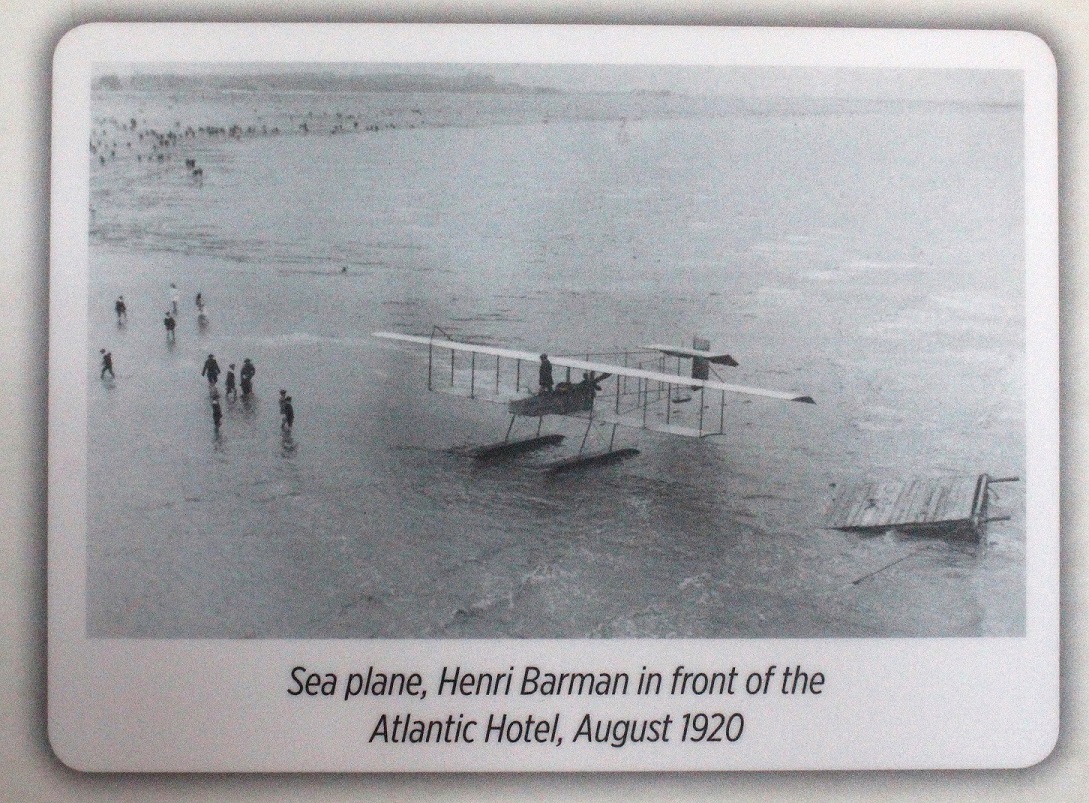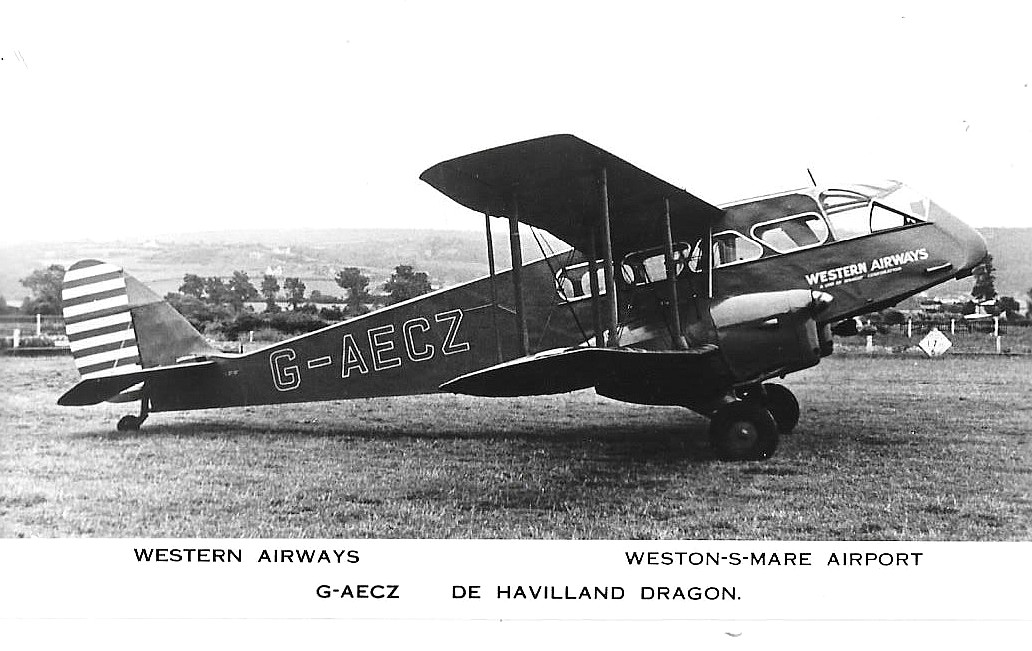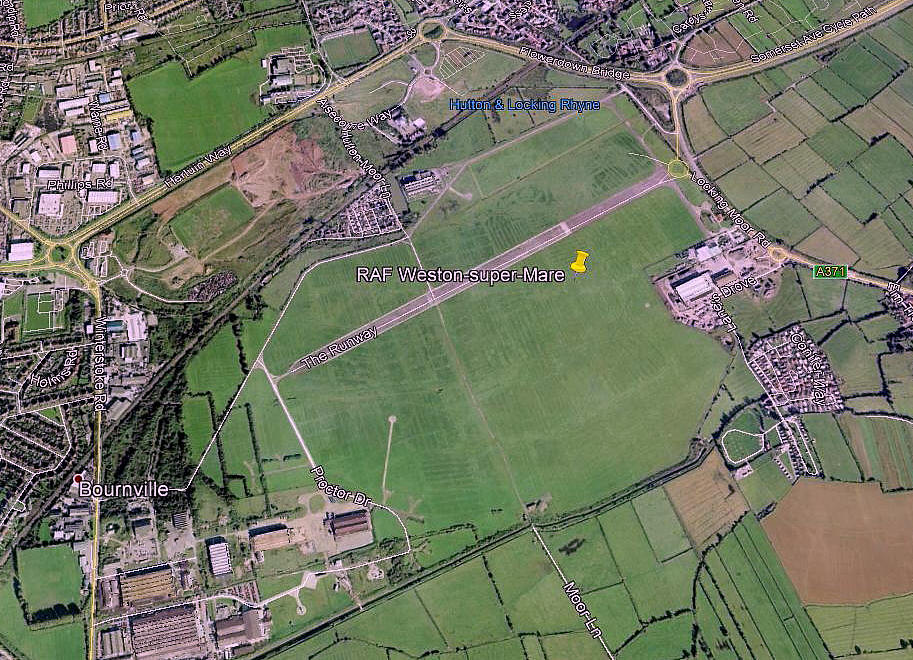Weston-super-Mare flying sites
Note: This map gives only the position of the town within the UK.
WESTON-SUPER-MARE see also BREAN DOWN FARM
WESTON-SUPER-MARE see also LOCKING ROAD
WESTON-SUPER-MARE see also THE SANDS AERODROME
WESTON-SUPER-MARE see also WOODSPRING PRIORY
WESTON-SUPER-MARE: Temporary beach flying site
This picture was obtained from the Heritage Centre, adjacent to 'The Helicopter Museum' on September 2019. It is dated 3rd August 1911, so just predates the other notes below. It has been a constant cause of wonder, the longer I research this project, as to how much more information regarding our amazing aviation heritage, still remains to be discovered. It will, without any doubt, be a lot - probably a hell of a lot. This 'Guide' is just a start.
NOTES:
According to an article by Eric Littledike in the Spring 2011 edition of Prop-Swing magazine: "On the 1st September, (My note: 1911), flying the repaired No.27 Mercury II, Hucks made a 40 minute non-stop flight from Weston-Super-Mare to Cardiff, Whitchurch, Landaff and back, having made the first double-crossing of the Bristol Channel by air." (My note: See listing for LOCKING ROAD).
I have also come across this account. On the 10th September 1911 Bentfield ‘Benny’ Hucks became the first aviator to cross the Bristol Channel flying from Weston-super-Mare to Cardiff. Such was the success of this flight B C Hucks was invited to return to Cardiff to give exhibition flights. An invitation it seems he accepted. So, where did he land and fly from at Weston - the beach probably? So who do you believe? An incessent and nagging problem when researching aviation history.
If we disclaim the assertion that this was the first crossing, (on the 10th), of the Bristol Channel, it does seem entirely plausible that Hucks made another flight to land at Cardiff.
It appears that the reliability of the Blackburn Mercury II on the first non-stop return flight over the Bristol Channel proved to both Hucks and Robert Blackburn (the manufacturer) that they had serious contender. This was later proved by Hucks who embarked on a tour of roughly 1,000 miles, and making something in the order of ninety seperate flights over a period of about three months. If only I could obtain a copy of that itinery! Presumably it would have started from Leeds, or perhaps even Filey where Blackburn had a flyng school.
OTHER USERS
It seems the beach must also have been used by Messrs Hubert, (possibly Fischer also?), in early September 1912. Hubert arriving from TORQUAY when he demonstrated a 70hp Farman floatplane sponsored by the Daily Mail after performing in the Teigmouth and Torbay area over the Bank Holiday. Except that Fischer was stranded at SOUTHAMPTON and Hubert struggled to make a couple of flights from TORQUAY after the Bank Holiday.
Hubert left for WESTON-SUPER-MARE on the next Friday following the Bank Holiday. This does raise some questions as the operation of a floatplane at WESTON does seem to present quite a few practical difficulties due to the huge tidal flow over a very flat area? When the sea goes out at WESTON it does so very quickly leaving a vast expanse of sand and mud.
The history trail seems to end here. Did Fischer join up with Hubert? Did either of them reach and operate at WESTON in September 1912? There are a lot of questions regarding the tour of these two pilots each with a Farman float-plane in 1912. Where did they start from? Where did they visit? Where did the tour end? Indeed, how on earth did they arrange and manage such a project in those days? The same applies of course for the bigger names in those days, Bucks, Grahame-White, Hamel & Salmet.
One item from the Fischer & Hubert visit caught my eye. It appears the visit caused quite a rumpus in the Council’s chambers when it was realised the Entertainments Committee hadn’t sought approval for laying out £75 a day on aircraft hire charges and not levying viewing charges at normally free public access areas. I wonder what £75 in 1912 would equal today? I believe you could easily buy a family house for £75 in 1912, but property hadn’t then started assuming investment potential for most people.
A QUERY
This picture in the Heritage Centre adjacent to 'The Helicopter Museum' is captioned as being taken in 1920. But the design is most definitely pre-WW1. I do not believe that pilots/owners/operators were still flying aircraft of this type after WW1, but perhaps I am mistaken? Any advice will be most welcome.
WESTON-SUPER-MARE: Civil aerodrome?
Pleasure flights: Avro Transport Co
Location: ? (From the beach or sands it seems)
Period of operation: 1919 to 1930s only?
NOTES: FLYING CIRCUS OPERATIONS
WESTON-SUPER-MARE is listed as a venue in June 1931 for CD Barnard Air Tours but did they use the ‘sands’ or possibly the aerodrome listed below? I’d reckon the sands simply because they would have been operating directly in front of the holiday-makers…but does anybody know for sure?
Also, the exact location for the site used on the 19th May 1933 by Sir Alan Cobham’s No.2 Tour when they visited WESTON-SUPER-MARE isn’t known either and the same applies to the 1934 Tour which displayed on the 18th April. Indeed on the 11th June 1935 WESTON-SUPER-MARE is also listed as the venue on the Cobham Tour itinerary but with no location. Possibly WOODSPRING PRIORY?
WESTERN AIRWAYS
In 1936 Western Airways were operating services, (up to 14 daily) from Cardiff, (probably from PENGHAM MOOR?) to Weston-super-Mare. Did they land on the beach or elsewhere? These services also connected to Bristol, (WHITHURCH?) and Swansea, (JERSEY MARINE?). It also appears they used a Percival Q6 for richer people to use from Manchester BARTON (?) and Birmingham, probably CASTLE BROMWICH?
WESTON-SUPER-MARE: Civil aerodrome, military aerodrome (WW2) then civil regional airport. Reopened as a helicopter landing area in 2003 according to one source but it was listed in a flight guide published in 2000.
(Also known as RAF LOCKING)
Military users: WW2: 10 EFTS (Tiger Moths)
Post 1945: Gliding: 621 VGS (listed 1997) (gliding also listed in 1975)
Operated by:
1965: Western Airways Ltd
1984: Westland Helicopters
2000: The International Helicopter Museum
Note: Please see my entry in the article 'Museums, gate guardians etc'.
Civil activities: Pre 1939 and post 1945: Airline, charter, air taxi, GA business, private, training and pleasure flights
Airline users:
Pre 1940: Southern Airways, Western Airways
Post 1945: Cambrian Air Services, Western Airways.
Notes: The picture caption states that the aircraft are Western Airways types and, by my reckoning comprise two DH.84 Dragons and one DH.89A Dragon Rapide. Note the control tower.
According to an entry in the 1957 'The Aeroplane' directory, Western Airways was a subsidiary of Airways Union Ltd with Auster Autocrats and a Miles Messenger and Miles Gemini. They also had bases at EXETER and PLYMOUTH (ROBOROUGH).
Gliding: 1981 Woodspring Gliding Club
A MIKE CHARLTON GALLERY FOR WESTERN AIRWAYS
Note: This fabulous collection of twelve pictures from postcards were kindly sent by Mike Charlton who has an amazing collection. See: www.avationpostcard.co.uk
First picture: The de Havilland DH60M Moth G-AAVR was first registered on the 29th March 1930, but I cannot seem to find the period it was operated by Western Airways. On the 20th September 1938 it was registered to the Redhill Flying Club (SURREY) and it appears it collided with a RAF Hawker Hart over Horley on the 8th May 1939.
Second picture: The de Havilland DH84 Dragon 1 G-ACAO was first registered on the 16th December 1932, but not registered to Western Airways until the 8th July 1938. It served with them until the 2nd April 1940 when it was impressed, presumably to the RAF, as X9398. It was registered as a nine-seater, but I assume that included the pilot?
Third picture: This is interesting I think. The de Havilland DH84 Dragon 1 G-ACJT was first registered on the 26th August 1933, but was later registered to Western Airways at Bristol Airport from the 16th March 1935 until the 9th February 1939. This 'Bristol Airport' location being WHITCHURCH. On the 14th February 1939 G-ACJT was registered here to Southern Airways, and it crashed here in December 1939.
Fourth picture: The de Havilland DH84 Dragon 1 G-ACMJ was first registered on the 7th December 1933. On the 1st July 1938 it was registered to Western Airways here, and served until the 2nd April 1940 when it was impressed as X9396.
Sixth picture: The de Havilland DH84 Dragon 2 G-ACPX was first registered on the 26th April 1934. On the 23rd July 1938 it was registered to Western Airways here and, just like G-ACMJ above, was also impressed on the 2nd April 1940, as X9399.
Eighth picture: The nine-seater (including pilot?), de Havilland DH89A Dragon Rapide G-ADBV was first registered on the 6th June 1935. It was registered to Western Airways and based here from the 1st November 1938 until the 12th January 1940. There then seems to be a curious gap before it was impressed on the 2nd April 1940 as X9399.
Ninth picture: Just a minor note, but this example was a DH89 Dragon Rapide, not a DH89A. It was first registered on the 8th June 1935, and as the caption says once enjoyed Royal patronage. It was registered to Western Airways, here at WESTON on the 1st November 1938 and served until the 4th June 1940 when it was impressed as AW116.
But, it might well have registered to Western Airways elsewhere before this as the message on the back of the postcard, dated 11/08/37 reads: "This is the machine in which I travelled each way. Left Cardiff Queens Sy 4.45pm and reached Weston promenade at 5.25pm. 10 mins in air!" It is very unfortunate that the CAA on-line database has been heavily edited and reduced for the 1920s and 1930s.
Tenth picture: I'm guessing of course, but suspect that as the DH84 Dragon 2 G-AECZ which was first registered on the 18th April 1936, it went first to Western Airways? On the 15th November 1937 it was registered to Ramsgate Airport Ltd until the 9th February 1939. A few days later, on the 14th February, it was registered to Southern Airways, also at RAMSGATE until the 8th May 1940 when it was impressed as AV982.
It managed to survive the RAF in WW2 and was registered to Air Taxis at CROYDON from the 18th June 1946 until the 15th December. Ir was then re-registered to Air Taxis from the 18th March 1947 until the 12th January 1948. It was then sold to Eire in March 1950 as EI-AFK.
Eleventh picture: What mixed bag this is, regarding the history of the Percival P.16A Q6 G-AFIX. Quite a lot doesn't match up. First registered on the 7th December 1938 (?) it appears to have gone to a private owner at CROYDON from the 4th December 1938 until the 13th March 1939. Then going to another private owner who based it at GATWICK from the 13th March until the 1st June 1939. It was then registered to Western Airways at WESTON-super-MARE from the 18th November 1939 until the 2nd April 1940 when it was impressed as X9406.
It seems to have emerged from WW2 as a Percival P.16A Q6 Mk.V Petrel, perhaps modified during RAF service? Equipped to carry four passengers with a toilet available. Most unusual for an aircraft of this type, and very 'up market' for the time. It was registered to London & Oxford Steel Co from the 31st May 1946 until the 13th August 1946, barely four months before going to Air Kruise at LYMPNE (KENT) for barely two months, from the 1st October to the 26th November 1946. I expect there is a story to be told here?
It then passed in quick succession to two private owners. And reported as crashed at Broomhill on the 6th May 1949. However, on the 7th January 1949 it was registered to Mr Noel Rodnight, co-founder of Starways, and used for ferrying celebrities to and from Blackpool. Reported as crashed in May 1950, it remained on the UK register until the 18th March 1959. Any advice will be most welcome.
Twelth picture: The de Havilland DH89A Dragon Rapide G-AFSO was first registered on the 21st April 1939 to Western Airlines, and based here until the 4th January 1940. On the 23rd January 1940 it was impressed, presumably to the RAF, as W6457. It does not appear to have survived WW2 with the RAF.
Charter, air taxi: Post 1945: Bristol Air Taxis
Another picture from a postcard sent by Mike Charlton.
Note: It is quite possible that my first ever flight was in this aircraft?.
However, the history of G-AMZV is rather interesting. Registered on the 28th March 1953 it appears the first owner was Saunders-Roe at East Cowes on the Isle of Wight who operated it from the 28th May 1953 until the 30th April 1960. It then went to Grantchester Garage in Cambridgeshire from the 4th May 1960 until the 26th November 1960.
It then went to Mellers Coaches, Goxhill, Lincolnshire, before finally being registered to Mell-Air, Goxhill, from the 4th June 1962 before crashing here on the 28th August 1966. It was then, and still is, the business of aircraft owners to often rent and lease aircraft to various operators, so I suspect this was the case here? Or - did Mell-Air set up a joy-riding operation here?
Manufacturing: Westland Helicopter Company factory
Location: W of A371, W to WSW of RAF LOCKING, NNW of Hutton, 2nm SE of Weston-Super- Mare
Period of operation: 1919 to 1960s? Some records say 1936 to beyond 1985. Listed in 1975 as being open to private aircraft
Note: This map is reproduced with the kind permission of Pooleys Flight Equipment. Copyright Robert Pooley 2014.
Runway(s):
Pre WW2: Grass airfield (Probably with 'all-over' use?)
WW2: 07/25 914x46 hard (Probably with grass runways too?)
1965: 07/25 1279x46 hard NNE/SSW 899 grass ESE/WNW 689 grass
2000 (Helicopters only) 1 acre grass landing area N of main buildings, W of museum
NOTES: Venue (19th & 20th August) for CWA Scott’s Flying Displays 1936 UK Tour.
I can now hopefully close one question. There is it seems some doubt as to whether or not this aerodrome was actually RAF LOCKING. In fact RAF LOCKING was a ground station situated almost next door, E of and and the other side of the A371.
In the early 1960s I had my first flight in a light aircraft here, in a Auster.
In 2003 approval was granted to start helicopter experience flights from the helipad near the Helicopter Museum.
PICTURE GALLERY
This is a combination of Google Earth © and my pictures. There is of course one of the most amazing museums dedicated to rotorcraft based here, right at the top of the best in the world. See my article concerning aviation museums - and scroll down to 'The Helicopter Museum'.
Another aspect is the control tower, still existing from the 1930s, alongside the pilots accommodation in WW2 - now a Heritage Museum and well a visit. Entry is included in the very reasonable fee for the Helicopter Museum.
Note: The third picture clearly shows the helipads used by Westland.
We'd love to hear from you, so please scroll down to leave a comment!
Leave a comment ...
Copyright (c) UK Airfield Guide








































